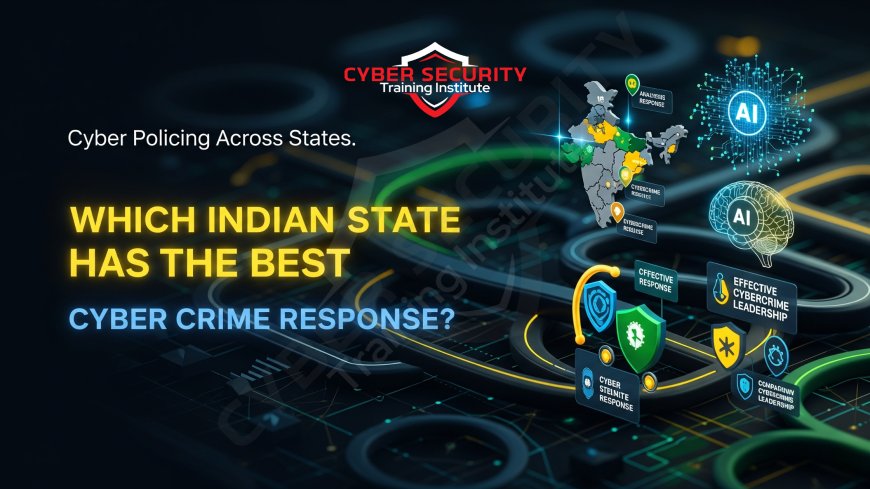Cyber Policing Across States | Which Indian State Has the Best Cyber Crime Response?
In today’s digital age, where smartphones, online banking, and social media are part of daily life, cybercrime has become a growing threat. From phishing scams to data breaches, cybercriminals are finding new ways to exploit vulnerabilities. In India, a country with over 918 million internet users as of 2024, the rise in cybercrime is alarming, with a 500% increase in cases reported between 2021 and 2024. But how are Indian states responding to this digital menace? Which state is leading the charge in cyber policing? In this blog, we’ll explore the state-wise efforts to combat cybercrime, compare their strategies, and determine which state stands out in 2025. This post dives into the mechanisms each state employs, from dedicated cybercrime police stations to public awareness campaigns, and evaluates their effectiveness. Whether you’re a tech enthusiast or someone looking to stay safe online, this guide will break down the complexities of cyber policing in a way that’s easy to understand.

Table of Contents
- Overview of Cybercrime in India
- State-Wise Cybercrime Response Efforts
- Comparing State Responses
- Which State Has the Best Cybercrime Response?
- Challenges in Cyber Policing
- Conclusion
- Frequently Asked Questions
Overview of Cybercrime in India
Cybercrime includes any illegal activity conducted using digital devices or the internet, such as hacking, phishing, ransomware, or identity theft. In India, the rapid growth of internet users—918.19 million by September 2024—has made the country a prime target for cybercriminals. According to the Ministry of Home Affairs, over 6.5 million cybercrime incidents were reported on the National Cybercrime Reporting Portal (NCRP) from 2021 to June 2025. Financial fraud, including scams impersonating government officials, is among the most common cybercrimes, with losses reaching ₹11,333 crore in the first nine months of 2024 alone.
The Indian government has taken steps to address this, including the establishment of the Indian Cyber Crime Coordination Centre (I4C) and the National Cybercrime Reporting Portal (cybercrime.gov.in). However, since policing is a state subject under the Indian Constitution, states and Union Territories (UTs) are primarily responsible for preventing, detecting, and investigating cybercrimes. This leads to variations in how each state tackles cybercrime, with some states excelling while others lag behind.
State-Wise Cybercrime Response Efforts
Let’s look at how some of India’s major states are addressing cybercrime, focusing on their infrastructure, initiatives, and results in 2025.
Maharashtra
Maharashtra, the financial hub of India, reported the highest number of cybercrime cases in 2024—3.03 lakh cases. The state has responded by establishing multiple cybercrime police stations, such as those in Pune, Nagpur, and Thane. The Maharashtra Cyber Division, under the Home Department, operates a dedicated website (mhcyber.gov.in) and has blocked over 83,000 WhatsApp accounts and 3,962 Skype IDs involved in scams. The state also benefits from the National Cyber Forensic Laboratory in New Delhi, which supports its investigations.
Uttar Pradesh
With 3.01 lakh cases in 2024, Uttar Pradesh is close behind Maharashtra. The state has set up cybercrime police stations in major cities like Lucknow and Noida. Uttar Pradesh also runs awareness campaigns through the I4C’s CyberDost initiative, educating citizens about scams like digital arrest frauds. The state’s police have been trained through the CyTrain portal, enhancing their ability to handle complex cyber investigations.
Karnataka
Karnataka, home to India’s tech capital Bengaluru, reported 1.7 lakh cases in 2024. The state has invested heavily in cyber forensics, with specialized units in Bengaluru and Mysuru. Karnataka’s police collaborate with tech companies to stay ahead of emerging threats like AI-driven phishing and deepfakes. The state also hosts Joint Cyber Coordination Teams (JCCTs) to coordinate with other states.
Telangana
Telangana stands out with 9,581 cases reported in 2022, the highest per the NCRB’s ‘Crime in India’ report. In 2024, the state established seven new cybercrime police stations to handle cases involving losses above ₹1 lakh. Hyderabad, a cybercrime hotspot, is part of the JCCT network, enabling better inter-state coordination. Telangana’s proactive approach includes public awareness drives and partnerships with financial institutions to prevent fraud.
Tamil Nadu
Tamil Nadu has taken a lead in setting up the maximum number of cybercrime police stations in the country, as noted in posts on X. The state’s police have been trained extensively through the CyTrain portal, and they actively use the Samanvaya Portal for data sharing and analytics. Tamil Nadu’s focus on capacity building has made it a model for others.
Comparing State Responses
To evaluate which state has the best cybercrime response, we can compare key metrics: the number of cybercrime police stations, training programs, public awareness initiatives, and the number of cases resolved. The table below summarizes these efforts for the top states in 2024.
| State | Cybercrime Police Stations | Cases Reported (2024) | Training Programs | Awareness Campaigns | Cases Resolved |
|---|---|---|---|---|---|
| Maharashtra | 20+ | 3.03 lakh | CyTrain, I4C workshops | CyberDost, radio campaigns | ~10,000 |
| Uttar Pradesh | 15+ | 3.01 lakh | CyTrain, state workshops | CyberDost, SMS alerts | ~8,000 |
| Karnataka | 10+ | 1.7 lakh | CyTrain, tech partnerships | Cyber Surakshit Bharat | ~7,500 |
| Telangana | 7 | 1.2 lakh | CyTrain, JCCT training | Bank partnerships, SMS | ~6,000 |
| Tamil Nadu | 25+ | 1.1 lakh | CyTrain, state programs | CyberDost, local media | ~9,000 |
Note: Data is approximate and based on available reports up to June 2025.
Which State Has the Best Cybercrime Response?
Determining the “best” state requires looking at both quantitative and qualitative factors. Maharashtra and Uttar Pradesh report the highest cases, but this could reflect better reporting mechanisms rather than higher crime rates. Tamil Nadu stands out for its extensive network of cybercrime police stations and strong training programs. Karnataka’s tech-driven approach, with partnerships in Bengaluru, gives it an edge in tackling sophisticated crimes like deepfakes. Telangana’s recent investments in new police stations and inter-state coordination are also commendable.
However, Tamil Nadu appears to lead due to its proactive infrastructure development and focus on capacity building. The state’s high number of cybercrime police stations and effective use of I4C tools like the Samanvaya Portal make it a model for others. While Maharashtra and Karnataka are close contenders, Tamil Nadu’s comprehensive approach gives it a slight edge in 2025.
Challenges in Cyber Policing
Despite these efforts, states face several challenges:
- Lack of Uniformity: Each state has different resources and priorities, leading to inconsistent responses.
- Underutilized Funds: Reports indicate that 17–51% of funds allocated for cyber forensic labs remain unspent, delaying upgrades.
- Emerging Threats: AI-driven scams and deepfakes are evolving faster than many states’ capabilities.
- Public Awareness: While campaigns like CyberDost are effective, rural areas still lack sufficient education on cyber safety.
- Inter-State Coordination: Cybercrimes often cross state borders, but coordination between states is still developing.
Addressing these challenges requires increased funding, better training, and stronger inter-state collaboration through initiatives like the JCCTs.
Conclusion
Cybercrime is a growing challenge in India, with states like Maharashtra, Uttar Pradesh, Karnataka, Telangana, and Tamil Nadu leading the fight. Each state has unique strengths, from Maharashtra’s forensic capabilities到一个 Nadu’s extensive police network. Tamil Nadu stands out as the leader in 2025 due to its robust infrastructure and proactive training programs. However, no state is immune to the challenges of emerging threats and resource constraints. As cybercrimes evolve, states must continue to innovate, collaborate, and educate citizens to stay ahead of digital criminals. By learning from each other’s successes, India can build a stronger, more unified cyber policing framework.
Frequently Asked Questions
1. What is cybercrime?
Cybercrime involves illegal activities using computers or the internet, such as hacking, phishing, or financial fraud.
2. Which Indian state reported the most cybercrimes in 2024?
Maharashtra reported the highest with 3.03 lakh cases, followed closely by Uttar Pradesh with 3.01 lakh cases.
3. How does India handle cybercrime nationally?
The Indian Cyber Crime Coordination Centre (I4C) and the National Cybercrime Reporting Portal (NCRP) coordinate efforts, but states handle most policing.
4. Why does Tamil Nadu lead in cybercrime response?
Tamil Nadu has the most cybercrime police stations and strong training programs, making it highly effective.
5. What is the National Cybercrime Reporting Portal?
It’s an online platform (cybercrime.gov.in) where citizens can report cybercrimes and check suspicious identifiers.
6. How many cybercrime cases were reported in India from 2021 to 2025?
Over 6.5 million cases were reported to the NCRP by June 2025.
7. What is the role of the Indian Cyber Crime Coordination Centre (I4C)?
I4C coordinates cybercrime efforts, provides forensic support, and runs awareness campaigns like CyberDost.
8. What are Joint Cyber Coordination Teams (JCCTs)?
JCCTs are inter-state teams in hotspots like Hyderabad and Ahmedabad to improve coordination against cybercrime.
9. How does Karnataka tackle cybercrime?
Karnataka uses tech partnerships and forensic units in Bengaluru to address sophisticated crimes like deepfakes.
10. What is the CyTrain portal?
It’s an online platform by I4C to train police and judicial officers in cybercrime investigation and forensics.
11. How many SIM cards were blocked to curb cybercrime by February 2025?
Over 7.81 lakh SIM cards and 2.08 lakh IMEIs were blocked.
12. What is the Samanvaya Portal?
It’s a platform for law enforcement to share cybercrime data, map activities, and coordinate investigations.
13. Why do cybercrimes vary across states?
States have different resources, population sizes, and digital penetration, affecting crime rates and responses.
14. What are common cybercrimes in India?
Financial fraud, phishing, ransomware, and crimes against women and children are prevalent.
15. How does Telangana fight cybercrime?
Telangana has new cybercrime police stations and collaborates with banks to prevent financial fraud.
16. What is the CyberDost initiative?
It’s an I4C awareness campaign using social media, SMS, and radio to educate citizens about cyber safety.
17. Why is inter-state coordination important?
Cybercrimes often cross state borders, requiring collaboration to track and apprehend criminals.
18. What challenges do states face in cyber policing?
Challenges include underutilized funds, lack of uniformity, and emerging threats like AI-driven scams.
19. How can citizens protect themselves from cybercrime?
Use strong passwords, avoid sharing OTPs, and report suspicious activity on the NCRP.
20. What is the future of cyber policing in India?
With growing digitalization, states will need advanced forensics, better coordination, and more public awareness.
What's Your Reaction?
 Like
0
Like
0
 Dislike
0
Dislike
0
 Love
0
Love
0
 Funny
0
Funny
0
 Angry
0
Angry
0
 Sad
0
Sad
0
 Wow
0
Wow
0
















